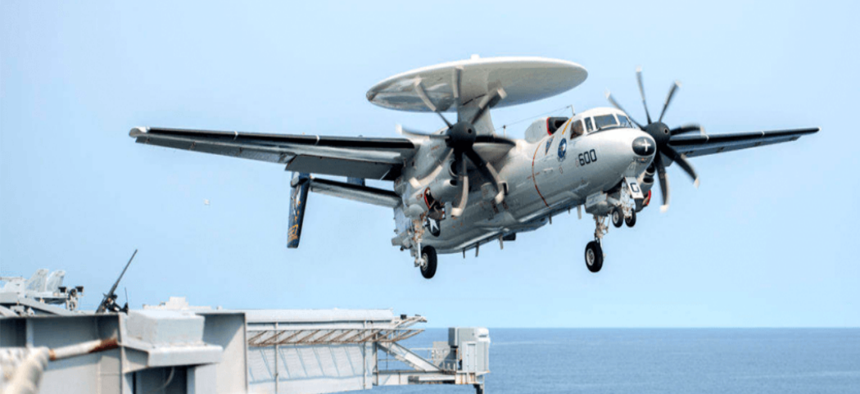Navy upgrades command and control tech for E2-D Hawkeye surveillance plane
An upgraded amplifier for the E2-D Hawkeye will improve the transmission of ISR targeting and tracking data.
The Navy is upgrading its E-2D Hawkeye Link 16 systems for faster, real time intelligence sharing and communication among air and ground forces.
The service is moving to the 1000-watt amplifiers for better sound quality when receiving messages from radios.
The Hawkeye, originally developed in 1960 by Northrop Grumman, is used primarily for battle management. Hawkeyes go in first and gather intelligence before sending in targeting data. The E-2D Hawkeyes used today, developed in 2007, deliver “actionable data to joint forces and first responders,” a Northrop Grumman statement said.
Hawkeyes are currently equipped with a Joint Tactical Information Distribution System (JTIDS). JTIDS are radios that distribute information not only between soldiers and commanders, but also between aircraft, ships, and ground forces. JTIDS can also broadcast information across all branches of the military.
When distributing information, Hawkeyes use Link 16, a tactical data exchange network used by the military to send information amongst soldiers and higher-ups. This information can include accurate position location, tactical images, as well as text messages and digital voice calls.
The importance of this technology in the Hawkeye is paramount to the success of the missions they fly in. JTIDS and Link 16 allow for jam free and reliable connections that allow constant communication. Messages can be sent to commanders and back from the edges of battle fields to command centers - and back again – while minimizing risk of a dropped signal.
This contract was awarded as part of the Small Business Innovation Research Program (SBIR). According to the SIBR statements, it is “a highly competitive program that encourages domestic small business to engage in Federal Research/Research and Development that has the potential for commercialization.”
The work will be done in Kapolei, Hawaii and Carlsbad, California with an anticipated completion in November 2020. The Naval Air Warfare Center Aircraft Division in Lakehurst, New Jersey is the contracting activity. North Star Scientific in Kapolei, Hawaii was awarded $14 million for the work.





